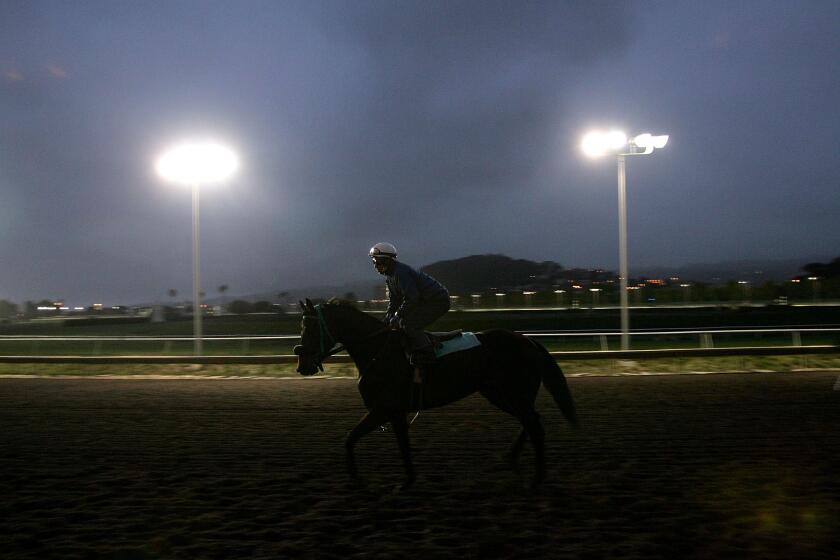Thoroughbred deaths put horse racing under scrutiny despite safety advancements

- Share via
DEL MAR — It’s been five years since a horse died as the result of racing in the Breeders’ Cup. It was 2019, a year that was both the best and worst for a sport that is struggling for relevance in the sporting landscape.
Racing fatalities became a national obsession as horses kept dying at Santa Anita. Mongolian Groom suffered a fatal injury to his left-hind leg at the top of the stretch in the biggest Breeders’ Cup race, the Classic. He was the 37th fatality at the track since Dec. 30 of the previous year.
An investigation by the Breeders’ Cup, showed that the death could have been prevented.
“The examining veterinarians made the right call on 252 horses,” the report said. “That is a 99.6% accuracy rate. The decision was wrong on only one horse: Mongolian Groom.”
The tragedies at Santa Anita spurred The Stronach Group and the California Horse Racing Board to institute a series of rules changes that made the sport safer. A lot safer. Since 2019, racing deaths in California have been reduced by 40%. Without the intense public and media scrutiny, it’s unclear what safety improvements would have been implemented. In a tragic sort of way, without the crisis, the sport may not have moved so quickly to address the problem.
Thorpedo Anna could be the star of the Breeders’ Cup, but City of Troy and Fierceness are among the favorites to win the $7-million Breeders’ Cup Classic.
California was the model for change, with most of its policies adopted by the Horseracing Integrity and Safety Authority (HISA), the national organization that was tasked with creating uniformity in racing rules and regulations. HISA was created in the wake of Santa Anita.
But with all the progress being made, and a true effort to fix this problem that generally repels people from the sport, the numbers are starting to go back up in California. According to statistics provided by the CHRB, the state had 128 fatalities in 2019, 96 in 2020, 71 in 2021, 64 in 2022 and 82 last year.
Sadly, 2019 was not the low point. In 2016, 209 race horses died in California.
It raises the question: Has horse racing plateaued in its effort to make the sport safer? One fact you can’t escape is that horses will die in racing, despite all efforts.
“I don’t think there is a bottom because there are a lot of untapped areas we can work on,” said Lisa Lazarus, chief executive of HISA. “There are analytics, which we are getting better at all the time. Then there are the surfaces. But there is still a lot we don’t know and research that is available.
“Will we be able to reduce to the levels we did this year? Probably not. Will we have some years that are better than others? Probably. But I don’t think there is a bottom to it other than zero is unlikely.”
Five more horses have died at a barn at Los Alamitos, bringing the total to 12 deaths as a result of an outbreak of equine infectious anemia.
In the second quarter of this year, the death rate at HISA tracks was 0.76 per 1,000 starts. In the first quarter it was 0.84, and in the fourth quarter of 2023 it was 0.89.
The problem is that it tells only half the picture. The metrics deal with racing deaths only, not training deaths. Lazarus says they are working on a new metric that includes training deaths, and they hope to implement it next year.
Racing is not above trying to play with statistics to present a misleading view of deaths.
At the conclusion of the winter/spring season at Santa Anita, the track put out a news release claiming that it was “the safest track in North America among those with a comparable volume of racing and training.”
It cited a 99.97% safety record based on a made-up timetable of the fall meeting of 2023 and the long winter/spring meeting of 2024. It also excluded tracks that didn’t race as often as Santa Anita, such as Del Mar, which had no racing-related fatalities in 2023 on a shorter racing schedule.
Santa Anita had two racing fatalities during that time period. But nowhere did it mention the seven horses that died in training. Five from musculoskeletal injuries and two by sudden death.

When asked about why training deaths were not included, a track official said: “Not all jurisdictions make their training statistics available, though HISA is pressing to include them in the Equine Injury Database.”
Despite the deception, there is no doubt that racing and training in California is much safer than it used to be.
“In a very real way we’ve addressed a lot of the low-hanging fruit with medication reform, expanded veterinary examinations, more observation and things like that,” said Scott Chaney, executive director of the CHRB. “Going forward, to keep driving those numbers down, we’re going to use more technology. AI will certainly be important going forward.
“But it’s fair to acknowledge that when you get to a certain number, it gets to be more difficult to get rid of the next one. We’re dedicated to that and we won’t stop until it gets to zero.”
Virtually everyone in the industry agrees that zero is an unattainable number.
“We are seeing the next wave, which will really help us,” said Dr. Will Farmer, who heads the Breeders’ Cup veterinary team. “Things such as wearable technology and advanced diagnostics like the PET machine will help.
“On the horizon we have some very meaningful pieces of technology that can really help us go to the next level. We have reached a plateau, but we’ve got things going that can reduce that number even more.”
After 83 years, Sunday is the last day of racing at Golden Gate Fields. The track will be missed for its inclusiveness and place in California racing history.
Some animal rights groups would like to see horse racing go away permanently. If that were to happen, the thoroughbred breed would be gone in the United States, as thoroughbreds are foaled almost exclusively for racing.
But, being a race horse is a lot safer than horses that live in the wild, or even on farms.
“One thing that is difficult to get across from a public relations standpoint is the veterinary care that thoroughbred horses receive is far superior to what horses would get if in the wild,” Lazarus said. “They get the best possible care. It’s not like they are in the wild suffering for six hours if they are injured. There is no good way to say that publicly.”
One other factor is that there will likely be fewer deaths because the foal crop is in serious decline, meaning fewer racehorses.
Of all of horse racing’s problems, there is little doubt, mostly because of 2019, that this is an issue that racing considers a major priority.
The issue never goes away but sometimes, such as this Friday and Saturday with the Breeders’ Cup at Del Mar, public scrutiny is at a very high level.
More to Read
Go beyond the scoreboard
Get the latest on L.A.'s teams in the daily Sports Report newsletter.
You may occasionally receive promotional content from the Los Angeles Times.












